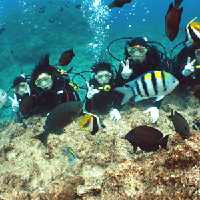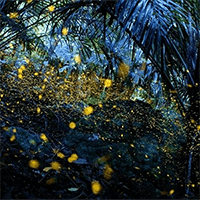Kansai in Guided tour
- Age 3~Age 80
- 1~2 hours
- 13:00
You can enjoy a full-scale sumo show supervised by former sumo wrestler Konishiki, a sumo experience, and a kimono haori experience. If you upgrade with an option, you can also enjoy traditional Japanese sumo cuisine. ☆ Flow of the day ☆ The reception is at the entrance of the store. Please arrive 30 minutes before the show. * In the unlikely event that you arrive after the show has started, please enter the store and proceed to the front of the torii gate as the curtains will be closed. A staff member will come to pick you up. ◎ From the time you arrive until the start of the sumo show, you can use the haori kimono that are available in the store while eating and using each booth. You can also take photos on the sumo ring. ・ Konishiki Booth You can actually see and touch the Konishiki booth, which displays the crested hakama, geta, and zabuton that Konishiki, the first foreign wrestler to reach the rank of ozeki, used to wear during his active career. ・ Kimono Booth You can use the kimono dressing service for a fee, and you can also purchase kimonos and obi (from 2,000 yen).・Food & Drinks You can also order and enjoy Chanko Nabe (2 servings from 4,000 yen) supervised by a sumo stable, street food, Japanese food (from 800 yen), and drinks (500 yen) at your seat. *If you are planning to eat or try on a kimono, we recommend that you arrive 60 minutes before the show starts. ◎Full-scale sumo show with sumo experience supervised by former ozeki Konishiki (approx. 50 to 80 minutes *5 minute break) ①Demonstration of sumo basics, movements, and rules (approx. 20 minutes) You can watch a full-scale sumo show supervised by Konishiki, a former sumo wrestler. You can learn about the basic movements of sumo, rules, winning moves, and prohibited moves. There is a quiz competition related to sumo and sumo wrestlers along the way, and if you answer the quiz correctly, everyone will receive a prize (sweets) ★ ③Best of three (approx. 5 to 10 minutes) A serious three-match match by former sumo wrestlers. It is a serious showdown without improvisation, where it is unclear who will win or lose. Everyone will throw a celebratory beanbag to the winning wrestler instead of a cushion. ④ Photo shoot (approximately 5-10 minutes) You will step onto the ring and take a photo with the former wrestler. *The photo will be taken with your mobile phone. You can also create a memorial label drink on the spot using the photo of your memories of today (1,000 yen). ⑤ Sumo experience (approximately 10-20 minutes) Wear a sumo suit or mawashi and wrestle with a former wrestler. You can feel the amazing power of the wrestlers. After the experience, you will take a photo with the wrestler while still in the sumo suit or mawashi. *Only available to those who wish to use the service on the day. We are trying to accommodate as many customers as possible, but if the number of applicants reaches the capacity, a lottery may be held. We may refuse use at the discretion of the staff, such as those who are drunk. Thank you for your understanding. ⑥ Calming Form - Ending - (approximately 2 minutes)
- Age 6~Age 70
- 1~2 hours
- 11:00 / 14:00 / 17:00 / 20:00
Osaka no Jin ⚔ Pilgrimage to sacred places refers to the stages of battles such as the 1614 (Keicho 19) battle "Osaka Winter Jin" and the 1615 (Genna 1) restarted battle "Osaka Summer Jin" and other battles. It is to visit places connected to Osaka Castle as sacred places with “SAMURAI STYLE”. In addition, the term ``Japan's best soldier, who acted with great courage and speed'' in that battle was a name used to praise Sanada Nobushige (Yukimura), who was loyal to his lord, did not betray him even with money or territory, and was close to Tokugawa Ieyasu during the Summer Siege in Osaka. . Yukimura Sanada shined dazzlingly as a Sengoku military commander in the battle that concluded the Sengoku period. His vivid life still fascinates many people today, and let's make a pilgrimage to the sacred place of his glorious battle at Osaka, where he was praised as ``the greatest soldier in Japan.''
- Age 6~Age 70
- 1~2 hours
- 11:00 / 14:00 / 17:00 / 20:00
Osaka no Jin ⚔ Pilgrimage to sacred places refers to the stages of battles such as the 1614 (Keicho 19) battle "Osaka Winter Jin" and the 1615 (Genna 1) restarted battle "Osaka Summer Jin" and other battles. It is to visit places connected to Osaka Castle as sacred places with “SAMURAI STYLE”. In addition, the term ``Japan's best soldier, who acted with great courage and speed'' in that battle was a name used to praise Sanada Nobushige (Yukimura), who was loyal to his lord, did not betray him even with money or territory, and was close to Tokugawa Ieyasu during the Summer Siege in Osaka. . Yukimura Sanada shined dazzlingly as a Sengoku military commander in the battle that concluded the Sengoku period. His vivid life still fascinates many people today, and let's make a pilgrimage to the sacred place of his glorious battle at Osaka, where he was praised as ``the greatest soldier in Japan.''
- Age 6~Age 70
- 1~2 hours
- 11:00 / 14:00 / 17:00 / 20:00
This is a plan to commemorate and make a pilgrimage to the sad sacred place where SAMURAI and his friends were defeated in the Osaka Siege in the last war and fell to the castle, wearing armor and helmets reminiscent of the battle. ~ A famous castle that records the history of prosperity and turmoil of the people of Japan ~ This is how Osaka Castle is introduced on its official website. However, there was no trace of Osaka Castle, which boasted of being impregnable, as all of the moats other than the main castle and the moat that had been dug back during the peace of Ieyasu's plot at the Osaka Siege were filled in. The Tokugawa army destroyed the Sanada army and invaded the castle one after another, led by the Echizen army led by Matsudaira Tadanao, who was the first to arrive.The fire set by a Tokugawa army informer in the main castle kitchen quickly destroyed the castle tower. Osaka Castle finally fell at midnight on the 7th. When Hinomoto's greatest soldier, Nobushige, was a hostage of the Toyotomi family, he was liked by Toyotomi Hideyoshi, so he was treated more like a vassal than a hostage. The reason Yukimura sided with Toyotomi, who was at an overwhelming disadvantage at the Battle of Osaka, was to protect his loyalty to Hideyoshi. ``This Yukimura was summoned to a place where he was simply trying to prolong his life, and he was given honor as a samurai. This kindness cannot be replaced by land or money. ''When Ieyasu tried to persuade him to defect, he said, ``I have no intention of defecting even if I receive half of Japan.'' ``If you forget your debts and indulge in self-interest, can you call yourself a human being?'' he left behind the words of Hinomoto's greatest soldier.
最近チェックしたプラン
Please wait a moment
![[Izumisano City] ◎Sumo show + sumo & kimono experience ◎"A sumo culture experience that can only be experienced here★" ◎Elementary school students and younger can watch the show and experience sumo for free◎の画像](https://img.activityjapan.com/10/54127/10000005412701_hutKXWpl_3.jpg?version=1732506304)
![[Osaka/Tamatsukuri] Osaka no Jin "Hinomoto's No. 1 Soldier" pilgrimage tour guide (Tamatsukuri area)の画像](https://img.activityjapan.com/10/52625/10000005262501_xEnFGyJR_3.jpg?version=1706264164)
![[Osaka/Tennoji] Osaka no Jin "Hinomoto's No. 1 Soldier" pilgrimage tour guide (Tennoji area)の画像](https://img.activityjapan.com/10/52569/10000005256901_xEnFGyJR_3.jpg?version=1706258885)
![[Osaka/Osaka Castle] Pilgrimage tour guide to the sacred sites of famous castles that mark the history of prosperity and turmoil among the people of Japan (Osaka Castle area)の画像](https://img.activityjapan.com/10/52567/10000005256701_xEnFGyJR_3.jpg?version=1706257265)







